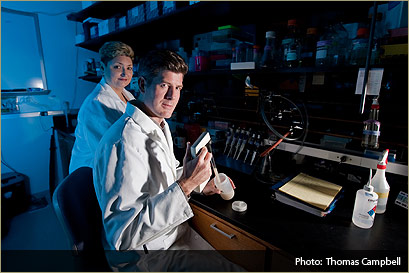
By Rolando Garcia
Natural Science and Mathematics Communications
In the slums of Calcutta, a University of Houston biology professor recently saw firsthand the kind of cholera patients his pioneering research could help treat one day.
Glen Legge’s work could pave the way for an antitoxin that would significantly reduce the severity of a disease that still is endemic in parts of the third world. In fall 2008 the assistant professor of biology and biochemistry was among a group of up-and-coming researchers chosen by the National Institutes of Health for a two-week trip to India.
They visited hospitals and clinics where patients are treated for cholera, tuberculosis and tetanus to personally observe the kind of rudimentary facilities and practical realities faced by health-care providers in poor countries.
The trip reinforced the imperative that future antitoxins developed through his research must be cheap and simple, Legge said.
He proposes attacking cholera at the molecular level. Cholera is a molecular Trojan horse that enters the body in an inactive form and then hijacks host cells.
Legge’s research is providing novel ways of understanding exactly how the bacteria toxin activates and takes over a cell. He envisions a simple antitoxin used in conjunction with existing oral rehydration therapies that would stop the cellular intoxication dead in its tracks to dramatically reduce the virulence of the infection.
Cholera currently is treated with oral hydration therapy, but a patient must still endure some 24 hours of massive diarrhea until the infection passes. Although antimicrobial drugs also can be used to fight cholera, they can lead to the creation of new drug-resistant mutations of the disease.
"This novel method of treatment we propose would attenuate the infection along the lines of a vaccine and remove the necessity to use antibiotics to treat the disease," Legge said.
An antitoxin would not only improve patient conditions but reduce the amount of infected waste being deposited into environments with little or no sanity disposal systems. |

